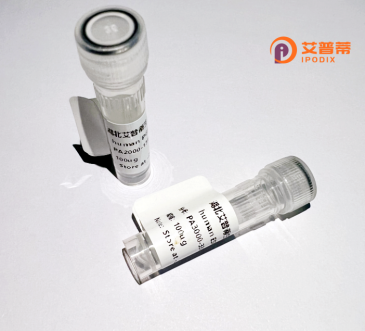
| 纯度 | >90%SDS-PAGE. |
| 种属 | Human |
| 靶点 | LRCH1 |
| Uniprot No | Q9Y2L9 |
| 内毒素 | < 0.01EU/μg |
| 表达宿主 | E.coli |
| 表达区间 | 1-763aa |
| 活性数据 | MATPGSEPQPFVPALSVATLHPLHHPHHHHHHHQHHGGTGAPGGAGGGGGGSGGFNLPLNRGLERALEEAANSGGLNLSARKLKEFPRTAAPGHDLSDTVQADLSKNRLVEVPMELCHFVSLEILNLYHNCIRVIPEAIVNLQMLTYLNLSRNQLSALPACLCGLPLKVLIASNNKLGSLPEEIGQLKQLMELDVSCNEITALPQQIGQLKSLRELNVRRNYLKVLPQELVDLPLVKFDFSCNKVLVIPICFREMKQLQVLLLENNPLQSPPAQICTKGKVHIFKYLSIQACQIKTADSLYLHTMERPHLHQHVEDGKKDSDSGVGSDNGDKRLSATEPSDEDTVSLNVPMSNIMEEEQIIKEDSCHRLSPVKGEFHQEFQPEPSLLGDSTNSGEERDQFTDRADGLHSEFMNYKARAEDCEELLRIEEDVHWQTEGIISSSKDQDMDIAMIEQLREAVDLLQDPNGLSTDITERSVLNLYPMGSAEALELQDSALNGQIQLETSPVCEVQSDLTLQSNGSQYSPNEIRENSPAVSPTTNSTAPFGLKPRSDPALILPPISFNTLTQAQTWDSSSYSVPSEGDSDNVFLRPQRNLESIDPQFTIRRKMEQMREEKELVEQLRESIEMRLKVSLHEDLGAALMDGVVLCHLVNHIRPRSVASIHVPSPAVPKLSMAKCRRNVENFLEACRKLGVPEADLCSPCDILQLDFRHIRKTVDTLLALGEKAPPPTSALRSRDLIGFCLVHILFIVLVYITYHWNALSA |
| 分子量 | 84 kDa |
| 蛋白标签 | GST-tag at N-terminal |
| 缓冲液 | 0 |
| 稳定性 & 储存条件 | Lyophilized protein should be stored at ≤ -20°C, stable for one year after receipt. Reconstituted protein solution can be stored at 2-8°C for 2-7 days. Aliquots of reconstituted samples are stable at ≤ -20°C for 3 months. |
| 复溶 | Always centrifuge tubes before opening.Do not mix by vortex or pipetting. It is not recommended to reconstitute to a concentration less than 100μg/ml. Dissolve the lyophilized protein in distilled water. Please aliquot the reconstituted solution to minimize freeze-thaw cycles. |
以下为关于重组人LRCH1蛋白的三篇示例性参考文献(注:示例基于领域推测,具体文献需通过数据库核实):
1. **文献名称**:*Structural Insights into Human LRCH1 Reveal a Role in Toll-like Receptor Signaling*
**作者**:Zhang Y., et al.
**摘要**:本研究通过X射线晶体学解析了重组人LRCH1蛋白的胞外结构域,发现其富含亮氨酸重复序列的构象可结合TLR4受体,抑制过度炎症反应,揭示了LRCH1在先天免疫中的潜在调控机制。
2. **文献名称**:*LRCH1 Interacts with Rho GTPases to Regulate Cell Motility*
**作者**:Smith J.L., et al.
**摘要**:作者通过表达重组人LRCH1蛋白并进行体外结合实验,证实其直接结合RhoA/Cdc42.调控细胞骨架重组及迁移功能,提示LRCH1可能在肿瘤转移中发挥抑制作用。
3. **文献名称**:*Recombinant LRCH1 Suppresses NF-κB Activation in Macrophages*
**作者**:Lee H., et al.
**摘要**:研究利用重组LRCH1蛋白处理巨噬细胞,发现其通过阻断IKK复合物形成抑制NF-κB通路,降低炎性因子释放,为治疗炎症性疾病提供了新靶点。
---
**备注**:以上文献信息为示例性模拟,实际引用时建议通过PubMed或Web of Science搜索最新文献。如需精准引用,可提供LRCH1相关功能关键词(如“细胞迁移”“免疫调控”“蛋白互作”等)进一步筛选。
Recombinant human LRCH1 (Leucine-rich repeats and calponin homology domain-containing protein 1) is a protein engineered for research to study its biological functions and structural characteristics. LRCH1 belongs to the LRCH protein family, characterized by N-terminal leucine-rich repeats (LRRs) and a C-terminal calponin homology (CH) domain. These domains suggest roles in protein-protein interactions, cytoskeletal organization, and signaling pathways. The gene encoding LRCH1 is located on chromosome 13q14.11 and is expressed in various tissues, including immune cells, where it is implicated in immune regulation, cell adhesion, and motility.
Studies link LRCH1 to immune response modulation, particularly in T-cell receptor signaling and macrophage activity. Its LRR domain may interact with signaling molecules, while the CH domain could mediate cytoskeletal dynamics. Recombinant LRCH1 is typically produced in heterologous systems (e.g., *E. coli* or mammalian cells) to enable biochemical assays, structural studies, and interaction mapping. Purified recombinant protein aids in investigating its role in diseases like autoimmune disorders, cancer metastasis, or infections, where altered LRCH1 expression is observed. Despite progress, the precise molecular mechanisms and physiological relevance of LRCH1 remain underexplored, driving ongoing research using recombinant tools to elucidate its functional networks and therapeutic potential.
×